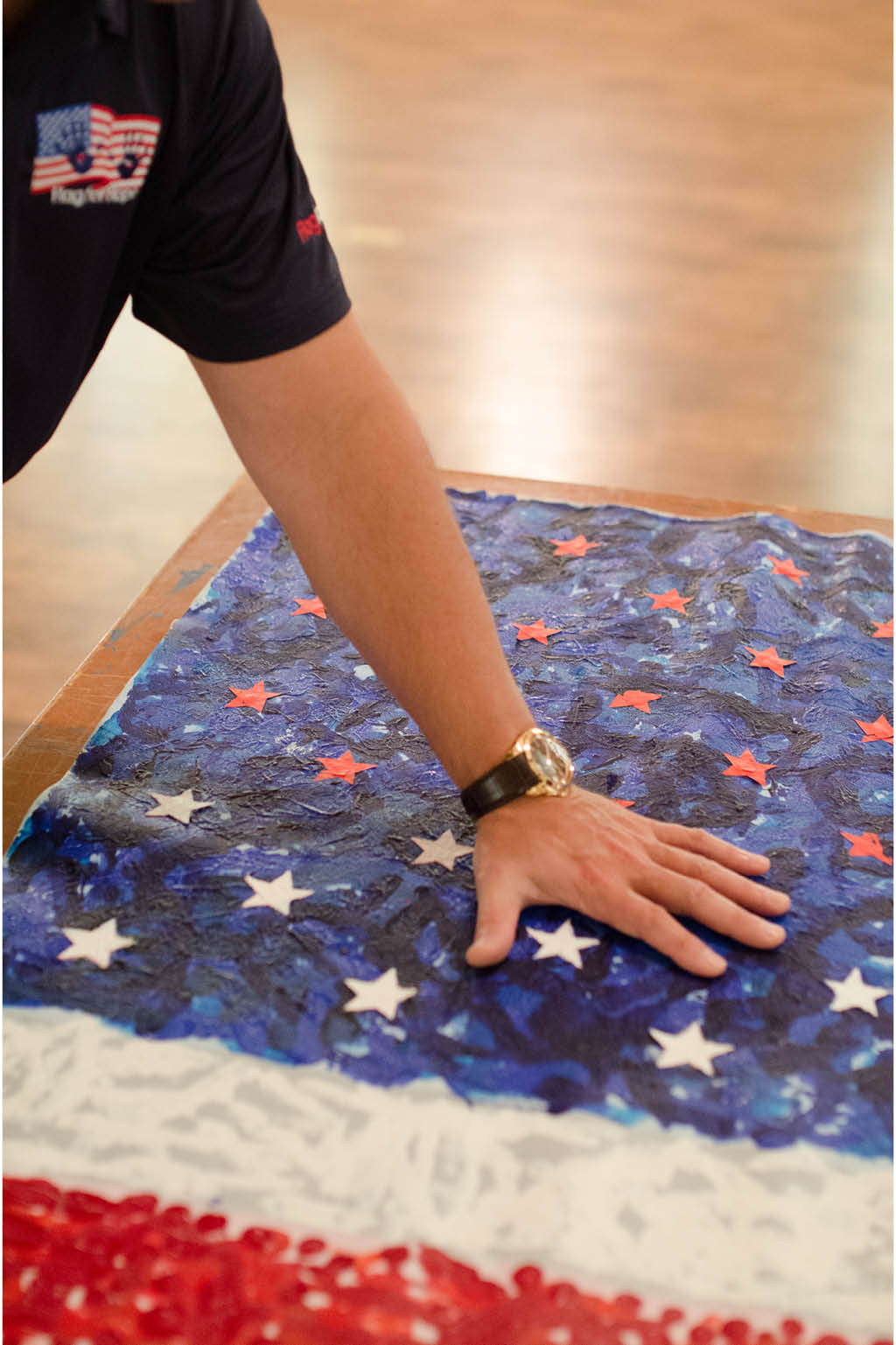Flag for Hope: Uniting the Country Through Art
A charcoal-colored button-down shirt, black jeans, red-tinted sunglasses, and a bowler hat with beige piping—if Marcos Antonio’s outfit could talk, it would whisper profundities with a suave Spanish accent. And this assessment proves true as the gentleman with the million-dollar smile relaxes on a piano bench in a Seattle community arts center to discuss Flag for Hope, his newest art venture–cum–social movement to unite the American people, and the path he took to get here. It’s apparent the journey has not been an easy one, as he speaks about his upbringing in the municipality of Baitoa in the Dominican Republic. “I didn’t have a pair of shoes until I was fourteen,” he recounts. “I didn’t have a bed until I was eleven. I ran around without proper clothing until I was nine years old. I was very poor, but I didn’t know I was poor. I had a family and my mother’s love. When I came to the United States, I finally saw the comparison.”
Antonio was raised by his mother—his father left when he was ten years old—and was surrounded by his sisters, as his five older brothers were away working. When he was seventeen, his family came to the United States in search of a better life and more opportunities. Antonio had never experienced electricity, cars, or plumbing—anything that resembled progress. He remembers walking through the airport late at night and experiencing electricity. “It was like daylight,” he says. “I couldn’t understand why I could see at night.”
The toughest part of culture shock was the language barrier. Antonio only knew Spanish, and everything was in English at school. He couldn’t communicate until he learned the language. And there were other unexpected anxieties. When his mother was first informed about the draft for the Vietnam War, she became frantic, telling her son that she would send him out of the country. Coincidentally, the refrigerator was hanging open; he looked at the fridge full of food and decided that this country was worth sacrificing for. He enlisted voluntarily, knowing he needed financial help for school anyway. “I’d finish high school at two o’clock and take the train from Brooklyn to Manhattan to wash dishes and mop floors,” he recalls. “I didn’t have the money to go to college. I knew I needed something else. When I heard the military gives you money for school, I signed up immediately.”

After his military service ended, Antonio’s visionary personality enabled him to discover ways to generate income. Perhaps foreshadowing his ultimate calling, Antonio decided to launch a cosmetics line. “I went to the mall a lot and watched what people spent their money on,” says the businessman. “Women buy a lot of cosmetics. I researched, and the markup is outrageous. I essentially spent fourteen years mixing color. That experience was the best foundation for a painter.”
Antonio enrolled in his first art class at the age of forty-four. With his business doing well and money in the bank, he felt a nudge to take a drawing class. Though the quietly effervescent Antonio was a quick study, his first painting didn’t go quite as planned. He laughs, “I bought my first canvas, and when I got it home, I realized it had two different sides. I called the people I bought it from and asked which side I should paint on. They told me the gesso side. The first painting I did was done on the wrong side!”
Though Antonio began as an abstract painter, he now devotes some of his time to painting butterflies. While engaging in this artistic endeavor, Antonio’s gentle spirit radiates. “When I was a kid, we had a piece of land. My job was to kill caterpillars. I was only four or five, but I was old enough to know they become butterflies. My mother saw that I was collecting the caterpillars instead of killing them,” he explains. “She grabbed me by the shoulder and said, ‘Now, Marcos, it’s either us or them.’ I understood what my mother meant. If you allowed the caterpillars to live, they would eat all the food overnight.”
This memory was filed away, though never far from his mind. While he was working on Impressions of Humanity, his large-scale global art project and social movement for unity, he encountered an older Native American man. Someone passing by had thrown a cigarette in the street, and the elderly man had picked it up. He advised Antonio that everything would be questioned when he crossed the path (a metaphor for dying). Antonio realized he’d better start painting butterflies to earn good karma. After all, behind the celebrity sunglasses are eyes that have seen more of the world than most of us have. Like a cat with nine lives, Antonio has cheated death numerous times as he faced opposition in several countries for creating the canvases and handprints for Impressions of Humanity.

No one saw the dangers of this project more clearly than Antonio’s longtime friend Chris Cavedon. The two met in Rhode Island and have been friends for over thirty years. Cavedon remembers, “When he told me he was going to try and unite the world with Impressions of Humanity, I tried to talk him out of it. I didn’t see an end game. He put all the time and effort into it. He almost lost his life several times. After eight years, four million dollars, and fifty canvas panels, Antonio ran out of money. I said, ‘Let’s do a flag, and let’s do it in the United States. And I’ll fund it.’” Flag for Hope was born.
The concept is simple—participants across the country make a fingerprint or a handprint with red, white, or blue paint to create the shape of a flag on a very large roll of canvas. Fifty Olympic athletes will also participate to represent the fifty states, and fifty iconic Americans will represent the white stars of the flag. In addition, 100 to 200 other people who most would consider well-known and deserving of this honor will participate. After participants make their impressions, Antonio films their response to the following question: What does the American flag mean to you? Cavedon sees a common thread in the answers, remarking, “Anyone who has fought in the military says the same thing: sacrifice.” He believes we could all take a lesson from that response by being kinder and sacrificing our own time or wants for a fellow human.
Both Cavedon and Antonio have seen Flag for Hope transform into something bigger than they had imagined, as they had originally only intended to pick a dozen of the major cities in the country to gain some attention. The project has morphed into thirty-five states, 150 cities, and 400 locations. This is the first time Cavedon turn it into something that will become historic enough to bring people together. And he’s seeing his vision gain clarity with each city they add to the roster. Cavedon is encouraged by what he hears from participants. “No one could have reached the people we did,” he says. “Most people dismissed this. Most people thought it would be impossible to gain the support of fifty Olympians. We just keep calling and calling.” Like Antonio, Cavedon has a vision for this project—to turn it into something that will become historic enough to bring people together. And he’s seeing his vision gain clarity with each city they add to the roster. Cavedon is encouraged by what he hears from participants. “It’s been uplifting to see how many people feel the same—they want to come together. They want to show pride in their country,” he explains. “When we come around, they thank us. It’s a wonderful feeling. I believe it’s going to become one of the most historic movements our country has seen in a long time.”
What’s most important about the flag is the blending of red, blue, and white impressions. “You can’t tell whether they’re from young or old, black or white, or religious or not,” says Cavedon. “They’re just Americans holding hands, saying that we want a brighter future.” After the flag is complete, Antonio and Cavedon plan to make a reproduction to help benefit a few charities, with the original flag donated
to a major museum. Like the caterpillars Antonio so badly wanted to save, this social art project is unfolding and transforming into a majestic social art movement.
For more info, visit flagforhope.com.























